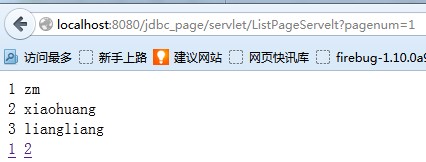0 保存大文本数据:
使用类PreparedStatement方法,将文本通过流方式读取/写入数据库
a) setCharacterStream(parameterIndex, reader, length): 保存数据
b) getCharacterStream(columnname);查询数据
public class JdbcClob {
/**
create table testclob
(
id int primary key auto_increment,
resume text
);
* @throws FileNotFoundException
*/
public static void main(String[] args) throws Exception {
find();
//insert();
}
public static void find() throws Exception{
Connection conn = null;
PreparedStatement st = null;
ResultSet rs = null;
try{
conn = JdbcUtils.getConnection();
String sql = "select resume from testclob where id=? ";
st = conn.prepareStatement(sql);
st.setInt(1, 3); // 第二个参数表示ID
rs = st.executeQuery();
if(rs.next()){
Reader reader = rs.getCharacterStream("resume");
char buffer[] = new char[1024];
int len = 0;
while((len=reader.read(buffer))>0){
System.out.println(new String(buffer,0,len));
}
}
}finally{
JdbcUtils.release(rs, st, conn);
}
}
public static void insert() throws SQLException, FileNotFoundException{
Connection conn = null;
PreparedStatement st = null;
ResultSet rs = null;
try{
conn = JdbcUtils.getConnection();
String sql = "insert into testclob(resume) values(?)";
st = conn.prepareStatement(sql);
URL url = JdbcClob.class.getClassLoader().getResource("resume.txt");
File file = new File(url.getPath());
FileReader reader = new FileReader(url.getPath());
st.setCharacterStream(1, reader, (int)file.length());
st.executeUpdate();
}finally{
JdbcUtils.release(rs, st, conn);
}
}
}
1 保存二进制 eg 图片: 项目中常把图片上传到服务器中,而在对应表中保存图片访问路径
使用类PreparedStatement方法,将二进制文件通过流方式读取/写入数据库
a) setBinaryStream(parameterIndex, inputstream, length): 保存数据
b) getBinaryStream(column);查询数据
public class JdbcImage {
/**保存二进制数据到数据库中
CREATE TABLE testblob
(
id INT PRIMARY KEY AUTO_INCREMENT,
image LONGBLOB
);
* @param args
* @throws Exception
*/
public static void main(String[] args) throws Exception {
//insert();
find();
}
public static void find() throws Exception{
Connection conn = null;
PreparedStatement st = null;
ResultSet rs = null;
try{
conn = JdbcUtils.getConnection();
String sql = "select image from testblob where id=1";
st = conn.prepareStatement(sql);
rs = st.executeQuery();
if(rs.next()){
InputStream in = rs.getBinaryStream("image");
byte buffer[] = new byte[1024];
int len = 0;
FileOutputStream out = new FileOutputStream("D:\\1.jpg");
while((len=in.read(buffer))>0){
out.write(buffer, 0, len);
}
in.close();
out.close();
}
}finally{
JdbcUtils.release(rs, st, conn);
}
}
public static void insert() throws Exception{
Connection conn = null;
PreparedStatement st = null;
ResultSet rs = null;
try{
conn = JdbcUtils.getConnection();
String sql = "insert into testblob(image) values(?)";
st = conn.prepareStatement(sql);
URL url = JdbcImage.class.getClassLoader().getResource("resume.jpg");
File file = new File(url.getPath());
FileInputStream in = new FileInputStream(url.getPath());
st.setBinaryStream(1, in, (int) file.length());
st.executeUpdate();
}finally{
JdbcUtils.release(rs, st, conn);
}
}
}
2 JDBC批处理:
第一种方式:
Statement.addBatch(sql)
执行批处理SQL语句
executeBatch()方法:执行批处理命令
clearBatch()方法:清除批处理命令
Connection conn = null;
Statement st = null;
ResultSet rs = null;
try {
conn = JdbcUtil.getConnection();
String sql1 = "insert into user(name,password,email,birthday)
values('kkk','123','abc@sina.com','1978-08-08')";
String sql2 = "update user set password='123456' where id=3";
st = conn.createStatement();
st.addBatch(sql1); //把SQL语句加入到批命令中
st.addBatch(sql2); //把SQL语句加入到批命令中
st.executeBatch();
} finally{
JdbcUtil.free(conn, st, rs);
}
采用Statement.addBatch(sql)方式实现批处理:
优点:可以向数据库发送多条不同的SQL语句。
缺点:
SQL语句没有预编译。
当向数据库发送多条语句相同,但仅参数不同的SQL语句时,需重复写上很多条SQL语句。例如:
Insert into user(name,password) values(‘aa’,’111’);
Insert into user(name,password) values(‘bb’,’222’);
Insert into user(name,password) values(‘cc’,’333’);
Insert into user(name,password) values(‘dd’,’444’);
第二种方式:
PreparedStatement.addBatch()
采用PreparedStatement.addBatch()实现批处理
优点:发送的是预编译后的SQL语句,执行效率高。
缺点:只能应用在SQL语句相同,但参数不同的批处理中。因此此种形式的批处理经常用于在同一个表中批量插入数据,或批量更新表的数据。
写法:
conn = JdbcUtil.getConnection();
String sql = "insert into user(name,password,email,birthday) values(?,?,?,?)";
st = conn.prepareStatement(sql);
for(int i=0;i<50000;i++){ // 5000可以理解成list.size(),list是封装参数的集合eg 5000个人的信息
st.setString(1, "aaa" + i);
st.setString(2, "123" + i);
st.setString(3, "aaa" + i + "@sina.com");
st.setDate(4,new Date(1980, 10, 10));
st.addBatch();
if(i%1000==0){
st.executeBatch();
st.clearBatch();
}
}
st.executeBatch();
3 JDBC分页:
3.1 MySQL分页支持的实现写法:
Select * from table limit M,N
M:记录开始索引位置(索引的角标从0开始计数,表第一个记录的角标为0)
N:取多少条记录
3.2 Oracle分页语句: 细节见本人博客oracle分页查询 那篇文章
select * from (
select rownum r_, row_.* from (
select * from student order by id
) row_ where rownum <=5
) where r_>=1
1位置:起始索引位置。
5位置:结束索引位置。
3.3 分页核心在于Page对象的设计,然后结合不同数据库分页查询具体sql写法,这两块实现分页,
page代码如下:
public class Page {
private int totalrecord; //总纪录数
private int totalpage; //总页数
private int pagesize = 3; //每页显示多少条
private int startindex; //记住从数据库哪个位置开始取页面数据
private List list; //该页的数据
private int foreachbegin;// 最左侧页码
private int foreachend;// 最右侧页码
public Page(int totalrecord,int pagenum){
if(totalrecord%pagesize==0){
this.totalpage = totalrecord/pagesize;
}else{
this.totalpage = totalrecord/pagesize + 1;
}
startindex = (pagenum-1)*pagesize;
if(this.totalpage<=10){
foreachbegin = 1;
foreachend = totalpage;
}else{
foreachbegin = pagenum-4;
foreachend = pagenum + 5;
if(foreachbegin<=0){
foreachbegin = 1;
foreachend = 10;
}
if(foreachend>this.totalpage){
foreachend = totalpage;
foreachbegin = this.totalpage-10+1;
}
}
}
params的 getter() setter() 方法.... }
mysql数据库分页写法如下:
public List getRecordByPage(int startindex,int pagesize){
Connection conn = null;
PreparedStatement st = null;
ResultSet rs = null;
try{
conn = JdbcUtils.getConnection();
String sql = "select * from student limit ?,?";
st = conn.prepareStatement(sql);
st.setInt(1, startindex);
st.setInt(2, pagesize);
rs = st.executeQuery();
List list = new ArrayList();
while(rs.next()){
Student student = new Student();
student.setChinese(rs.getDouble("chinese"));
student.setEnglish(rs.getDouble("english"));
student.setId(rs.getInt("id"));
student.setMath(rs.getDouble("math"));
student.setName(rs.getString("name"));
list.add(student);
}
return list;
}catch(Exception e){
throw new RuntimeException(e);
}finally{
JdbcUtils.release(rs, st, conn);
}
}
3.4 连接mysql数据库下分页案例:
效果如下:

表如下:
CREATE TABLE student(
id INT,
NAME VARCHAR(20),
chinese FLOAT,
english FLOAT,
math FLOAT
);
案例代码已打包,见 附件 jdbc_page.rar





 本文介绍JDBC在实际项目中的高级应用技巧,包括大文本数据和二进制数据的存储及检索、批处理操作以提高执行效率、以及分页查询的实现方法。
本文介绍JDBC在实际项目中的高级应用技巧,包括大文本数据和二进制数据的存储及检索、批处理操作以提高执行效率、以及分页查询的实现方法。
















 3046
3046

 被折叠的 条评论
为什么被折叠?
被折叠的 条评论
为什么被折叠?








